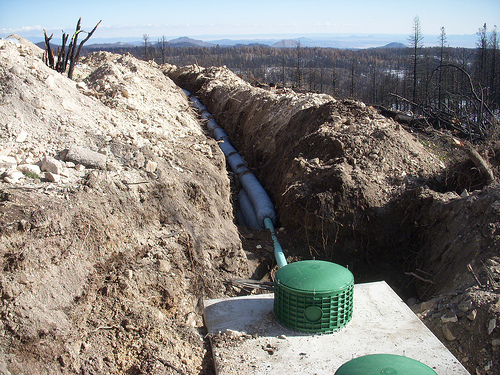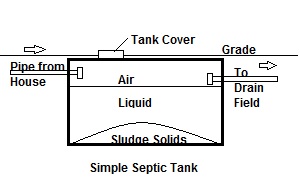Septic System Inspection: What Homeowners Need to Know
0 Comments | Posted by armchairbuilder in Build Your Own Home, Owner-Builder, Quality Check
Are you familiar with the important items to review for a septic system inspection? Depending on the location of your new home, you may not have city sewer service. If you have lived with municipal services your whole life, a septic installation can be foreign to you. Most of us have heard the horror stories of backups or raw sewage bubbling up in the yard (Did you see the movie father of the bride?). Septics get a bad wrap. Like many systems in your home, if you build and maintain them correctly, they can last for many years (up to 30 years in some cases).
Not Down The Drain!
Septic systems can be negatively affected by certain products that are put through your drain lines. When I say drain lines, I’m referring to toilets or any other drain in your home. Items that should not be run through your plumbing system include…
- Paint and solvents
- Feminine products
- Diapers
- Facial Tissues
- Dental Floss
- Grease
- Cooking Oils
To keep things simple, the only items that should go down the toilet are waste water and toilet paper.
Water softeners can also be hard on a septic system. They pump hundreds of gallons of water into the septic system all at once which can overload it. The salt content in the water can also pose a problem. Don’t forget, large quantities of salts are used to make the softener work. These can corrode components in the septic system over time and possibly affect the permeability of the soil.
Garbage disposals are something you will want to think carefully about before installing with a septic system. Certain food items are difficult to decompose and can create problems. As a builder, I would leave the disposal out if I was building my own home with a septic system.
Hot tubs can make a nice addition to any new home. However, it’s important to remember that these tubs can hold hundreds of gallons of water. Never allow the tub to be drained into your septic system as it can overload the tank and cause solids to make their way into the drain field causing them to clog.
A Trip to the County
If you are buying an existing home, your septic system inspection should start with the local county department that issues permits for septic systems. In many cases, they maintain information about each system that has been installed in their jurisdiction. Some things they frequently keep on file include…
- As-Built Diagrams: Showing the locations of tanks, leach fields, plumbing lines…etc.
- Installation Date: By knowing when the system was installed, you will have a better idea of the useful life left.
- Cleanings: Some counties maintain a database of cleanings. Each system should be cleaned every two to four years. If the system hasn’t been cleaned, it could mean trouble.
Basic Design
A septic system design will vary based on a couple important factors. First, the type of soil on the property will dictate the type of design required. Remember, effluent from the system will need to be absorbed by the soil and some soil types are not very conducive. A perc (i.e. percolation) test is typically done to determine the ability of the soil to absorb effluent.
The other factor affecting the system size and type is the number of bedrooms. Most counties estimate two people per bedroom to determine the size of the system required.
Here’s a quick description of how a septic system works. First the waste water exits your home through a sewer pipe. It them enters a tank. This tank typically has one, two or three sections that allow solids to settle out. The basic idea behind the system is for only liquids to leave the tank and be distributed to the drain field (a.k.a. leach field). A pump is sometimes used to force the liquid out of the last chamber in the septic tank and into the drain field. The field is typically installed a minimum of four feet above the water table or bedrock. The drain field involves pipes with holes in them run horizontally to allow the effluent to leave the pipe and percolate out into the soil.
Septic System Inspection
Whether you are building a new home or purchasing an existing one, it’s a good idea to know what to look for in a septic system inspection. Here are some key items to look for to make sure you are getting a quality system that will last for years. Keep in mind, there are dangerous gases in the typical septic tank from the natural treatment process. Never go into a tank. Extreme care should be taken when inspecting, even when just looking in.
- Clean out near house – The main sewer line that transports sewage from your home to the tank can get clogged. So, it’s a good idea to have a clean out pipe outside the home that rises vertically up above grade for easy access. By having this pipe outside the home, the messy job of cleaning can take place outside.
- No Dips in Pipe – For new systems, make sure there are no dips in the pipe running from the house to the tank. Low spots in sewer pipes can cause blockages to occur.
- Tank – The tank should be inspected for cracks and leaks. Any pipes or wires that penetrate the tank walls should be sealed up tight. Wire splices in the tank should be in air/water tight systems to prevent corrosion of the wiring. Gases in the tank can be very corrosive.
- Drain Field – The pipes in the leach field should be horizontal.
- No Landscaping – Only grass should be planted above or near the drain field. Why? Because roots from plants and trees can clog the drains.
- No Building Above – Nothing should be built above the drain field. Even posts from decks or fences can damage pipes.
- No Heavy Vehicles – No heavy vehicles should be operated over the drain pipes or drain field. These can put extreme pressure on the pipes and cause damage. It’s a good idea to place a fence around the system when building a new home or addition to prevent damage from deliveries or heavy equipment.
With proper installation, operation and maintenance, a home septic system can last for decades. It’s a good idea to have a qualified professional inspect your septic system on a regular basis. Have you thought about building a new home? Owner builders are saving tens of thousands of dollars and getting the home of their dreams. Check out our How to Build Your Own Home resources page for some great articles, videos, and pro builder resources to make it happen.



